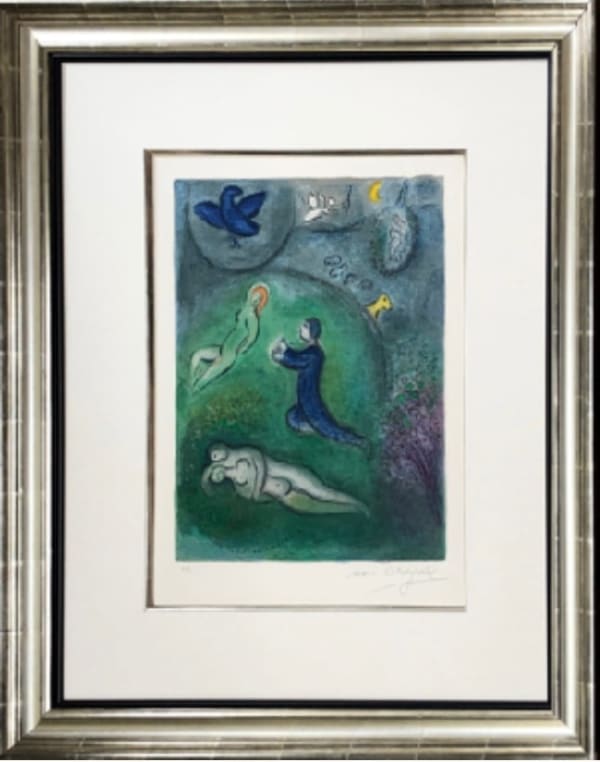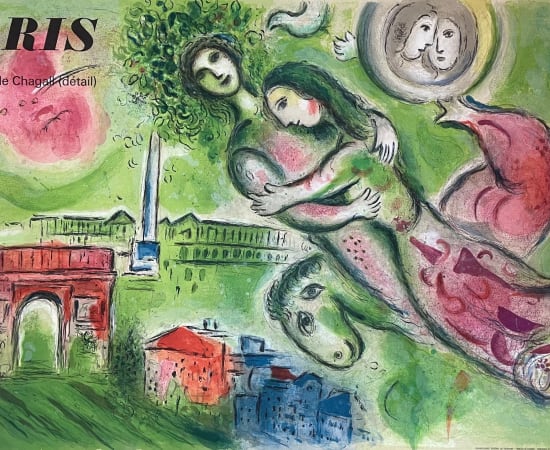Marc Chagall French - Russian, 1887-1985
Marc Chagall (1887–1985) – Biography
Marc Chagall was a Russian-French artist and one of the most prominent figures of modern art. Known for his dreamlike, poetic imagery and use of vibrant color, Chagall blended elements of Fauvism, Cubism, and Surrealism to create a unique and deeply personal style that celebrated love, folklore, and spirituality.
Early Life and Education
• Birth: July 7, 1887, in Liozna, near Vitebsk, Belarus (then part of the Russian Empire).
• Family: Raised in a Hasidic Jewish family, his upbringing heavily influenced his art, with themes of Jewish life and folklore appearing throughout his career.
• Education: Studied art in Saint Petersburg (1907–1910) under Léon Bakst and moved to Paris in 1910, immersing himself in the avant-garde art scene.
Artistic Style and Themes
Chagall’s art is characterized by dreamlike compositions, fluid forms, and symbolic imagery. Common themes include:
• Love and Romance: Frequently inspired by his wife, Bella, who was a recurring subject in his works.
• Jewish Culture: His childhood memories, traditions, and religious practices played a central role in his art.
• Folklore and Fantasy: Evoking surreal, fairytale-like worlds filled with animals, lovers, and village scenes.
• Color and Emotion: Known for his bold use of color to evoke emotion and spirituality.
Key Periods and Works
Paris (1910–1914):
• Chagall was inspired by the modernist movements, such as Cubism and Fauvism.
• Famous works: I and the Village (1911), Paris Through the Window (1913).
Russia (1914–1922):
• Returned to Vitebsk during World War I and became involved in cultural initiatives after the Russian Revolution.
• Founded the Vitebsk Art School in 1918 but clashed with avant-garde artists like Malevich.
• Created works like The Birthday (1915) and The Promenade (1917).
Paris and Exile (1923–1941):
• Returned to Paris but fled to the U.S. during World War II to escape Nazi persecution.
• Produced etchings for The Bible series and created stained glass and tapestry designs.
Later Life (1948–1985):
• Settled in France after the war, exploring large-scale projects, including stained glass windows, ceramics, and murals.
• Famous commissions include:
• The Ceiling of the Paris Opera (1964).
• Stained glass windows for the Hadassah Medical Center in Jerusalem.
Legacy
Marc Chagall remains celebrated for his lyrical style and ability to blend personal memory with universal themes of love and spirituality.
• His work bridges various artistic movements but is ultimately defined by his unique vision.
• Chagall’s stained glass and monumental works continue to inspire awe, alongside his paintings, etchings, and drawings.
• Major museums such as the Musée National Marc Chagall in Nice and the Museum of Modern Art in New York showcase his legacy.
Interesting Facts
• Chagall designed sets and costumes for the ballet Aleko (1942) and Igor Stravinsky’s The Firebird.
• He survived two World Wars and the Russian Revolution, yet his art retained its optimistic, dreamlike quality.
• He was the first living artist to have his work exhibited at the Louvre in Paris.



